President Biden is expected to be briefed on the lab leak theory conducted over the last 90 days. Very few expect solid results, although this might provide direction for more lines of inquiry.
President Joe Biden is expected to be briefed on the lab leak theory conducted over the last 90 days by the U.S. intelligence community. Very few expect any clear answers, including three U.S. government officials and a fourth individual familiar with the scope of the investigation. All told Reuters they didn’t expect solid results, although the report might provide direction for more lines of inquiry.
COVID-19 has killed about 4.6 million people worldwide. Although it originated in Wuhan, China, there are two prominent theories as to its biological origins. One is the “wet market” theory, which is that it occurred naturally in bats, transferred to other animals in a wet market in Wuhan, and then was transmitted to humans.
The other is the “lab leak” theory. This postulates that the virus probably occurred naturally in bats, was being investigated at a government-run laboratory, the Wuhan Institute of Virology (WIV). At WIV, researchers conducted gain-of-function experiments, making the virus more virulent, and through one sort of lab accident or another, was released into the general public.
Gain-of-function research is controversial. The argument for it is that it helps to understand viral evolution better and develop safer preventive measures. Critics argue that its minimal scientific value can create hazardous, more virulent viruses that could accidentally be released into the environment.
“It’s basically impossible to have a proper investigation if one of the main parties doesn’t want to cooperate,” said Thomas Wright, Brookings Institution senior fellow and co-author of “Aftershocks,” a book about the pandemic with Biden’s Under Secretary of Defense Colin Kahl. “We need to proceed as if both hypotheses are true.”
U.S. intelligence’s early reports leaned toward the wet market theory. A World Health Organization (WHO) investigation in January and February supported the wet market theory, although their probe has turned out to be very incomplete. SARS, caused by the SARS-CoV-1 virus, originated from a Chinese wet market, transferring from bats to, most likely, pangolins, then to humans.
In May, the WHO released a draft report of its international investigative team who visited Wuhan, China, from mid-January to mid-February. That report described four scenarios for the pandemic’s origins in order of likelihood, with the first being from bats via another animal. Bats to an intermediary to humans was “very likely.” Bats directly to humans was “possible,” and via “cold-chain” food storage was “possible, but not likely.” The lab leak theory was possible but “extremely unlikely.”
The only U.S. member of the WHO team has been criticized for conflicts of interest. Peter Daszak is a U.S. zoologist. Daszak’s nonprofit, EcoHealth Alliance, received more than $800,000 in grants from the National Institutes of Health’s National Institute of Allergy & Infectious Diseases (NIAID).
At least some of that money went as subgrants to the Wuhan Institute of Virology (WIV). In addition, Daszak is the author with other researchers of a Correspondence in The Lancet. In it, he declared no competing interests that largely debunked the lab-leak theory before he was assigned to investigate it.
Daszak and the WHO team argued in their cursory investigation that a lab leak was extremely unlikely. This is a position Daszak claimed long before the WHO investigation. In early summer, he also recused himself from the COVID-19 Commission established by The Lancet over accusations he hid his conflicts of interest earlier.
Although the evidence supporting the lab-leak theory is circumstantial, there is quite a bit of it. A State Department cable from 2018 has been noted where U.S. diplomats expressed concern over the WIV safety protocols. Also, a 2017 WIF promotional video that appeared on The Chinese Academy of Sciences (CAS) website, the state-run research institute that administers the WIV, showed researchers handling live bats and some of the technicians saying they’d been bitten while handling the animals.
Shi Zhengli, the WIV’s head bat coronavirus expert, publicly admitted she had concerns initially that SARS-CoV-2 might be related to her research. But she checked the records and was convinced it wasn’t. However, she published a study in 2017 in the journal Virological Sinica, and later in Nature, describing bat viral genomes collected from a mine where several miners died from a then-mysterious respiratory illness similar to COVID-19. The genome of that virus, RaTG13, has a genetic sequence 96.2% identical to SARS-CoV-2.
China has refused to provide access to the Wuhan laboratory, which would likely be necessary to prove or disprove the lab leak theory, assuming it can be proven at all. The Chinese government has pushed back hard on the lab-leak theory, although it has offered up other hypotheses that are even less likely, including that it came out of the U.S. Army Medical Research Institute of Infectious Diseases (USAMRIID) at Fort Detrick, Maryland.
Although the wet market theory is about as scientifically plausible as the lab leak theory, the evidence for it is also largely circumstantial, and scientists have not been able to identify an intermediate species yet that carried the virus from bats to humans.





